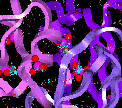 The CFF91 Forcefield
The CFF91 Forcefield
Contents
Note: because the Wilson out-of-plane definition is used in the CFF
forcefields, results calculated with the Discover 95.0/300 and
2.x.x programs should agree exactly.
The analytic expressions used to represent the energy surface are
shown algebraically in Eq. 3-2 and schematically
in Figure 3-4. Both
anharmonic diagonal terms and many cross terms are necessary, for a
good fit to structure and relative energies, as well as to vibrational
frequencies.
The CFF91 forcefield employs a quartic polynomial for bond stretching
(Term 1) and angle bending (Term 2) and a three-term Fourier expansion
for torsions (Term 3). The out-of-plane coordinate (Term 4) is defined
according to Wilson et
al. (1980). All the cross terms up through third order that have
been found to be important (Terms 5-11) are also included--this gives
a forcefield equivalent to the best used in a formate anion test case
(Maple et al. 1990). Term 12
is the Coulombic interaction between the atomic charges, and Term 13
represents the van der Waals interactions, using an inverse 9th-power
term for the repulsive part rather than the more customary 12th-power
term. Note that some first-generation forcefields use forms with
quadratic diagonals and a few use some cross terms--perhaps with Morse
potentials for bonds.
- Eq. 3-2:
-

The atom types of the CFF91 forcefield are described in Table 3-2.
The bond increment sections of the .frc files for both CFF91 and CVFF have been expanded so that partial charges
can be determined whenever the Discover program is able to
assign automatic atom types.
Table 3-2. Atom Types--CFF91
The format is:
- atom type
- description
and you may quickly jump to the classes of atom types by clicking:
- dw
- deuterium in heavy water (equiv. to h*)
- h
- hydrogen bonded to C or S
- hc
- hydrogen bonded to C (equiv. to h)
- hi
- hydrogen in charged imidazole ring
- hn
- hydrogen bonded to N (equiv. to h*)
- ho
- hydrogen bonded to O (equiv. to h*)
- hp
- hydrogen bonded to P (equiv. to h)
- hs
- hydrogen bonded to S (equiv. to h)
- hw
- hydrogen in water (equiv. to h*)
- h*
- polar hydrogen bonded to N or O
- h+
- charged hydrogen (in cation)
- c
- generic sp3 carbon
- ca
- general amino acid alpha carbon (sp3) (equiv. to c)
- cg
- sp3 alpha carbon in glycine
(equiv. to c)
- ci
- sp2 aromatic carbon in charged imidazole ring
(his+) (equiv. to cp)
- co
- sp3 carbon in acetal (equiv. to c)
- coh
- sp3 carbon in acetal with hydrogen
(equiv. to c)
- cp
- sp2 aromatic carbon
- cr
- carbon in guanidinium group (HN=C(NH2)2)
(arg)
- cs
- sp2 carbon in 5-membered ring next to
S (equiv. to cp)
- ct
- sp carbon involved in triple bond
- c1
- sp3 carbon bonded to 1 H, 3 heavy atoms (equiv. to c)
- c2
- sp3 carbon bonded to 2 H's, 2 heavy
atoms (equiv. to c)
- c3
- sp3 carbon in methyl (CH3) group
(equiv. to c)
- c5
- sp2 aromatic carbon in 5-membered
ring (equiv. to cp)
- c3h
- sp3 carbon in 3-membered ring with
hydrogens (equiv. to c)
- c3m
- sp3 carbon in 3-membered ring
(equiv. to c)
- c4h
- sp3 carbon in 4-membered ring with
hydrogens (equiv. to c)
- c4m
- sp3 carbon in 4-membered ring
(equiv. to c)
- c
- sp2 carbon in carbonyl (C=O) group in
amide
- c"
- carbon in carbonyl group, not amide (equiv. to c*)
- c*
- carbon in carbonyl group, not amide
- c-
- carbon in carboxylate (COO-) group
- c+
- carbon in guanidinium group
- c=
- nonaromatic end doubly bonded carbon
- c=1
- nonaromatic, next-to-end doubly bonded carbon
- c=2
- nonaromatic doubly bonded carbon
- n
- sp2 amide nitrogen
- na
- sp3 amine nitrogen
- nb
- sp2 nitrogen in aromatic amine
(equiv. to nn)
- nh
- sp2 nitrogen in 5- or 6-membered
ring, bonded to hydrogen
- nho
- sp2 nitrogen in 6-membered ring, next
to a carbonyl group and with a hydrogen (equiv. to nh)
- nh+
- protonated nitrogen in 6-membered ring
- ni
- sp2 nitrogen in charged imidazole
ring (his+) (equiv. to nh)
- nn
- sp2 nitrogen in aromatic amine
- np
- sp2 nitrogen in 5- or 6-membered
ring, not bonded to hydrogen
- npc
- sp2 nitrogen in 5- or 6-membered
ring, bonded to a heavy atom (equiv. to nh)
- nr
- sp2 nitrogen in guanidinium group
(HN=C(NH2)2)
- nt
- sp nitrogen involved in triple bond
- nz
- sp nitrogen in N2
- n1
- sp2 nitrogen in charged arginine
(equiv. to nr)
- n2
- sp2 nitrogen in guanidinium group
(HN=C(NH2)2) (equiv. to nr)
- n4
- sp3 nitrogen in protonated amine
(equiv. to n+)
- n3m
- sp3 nitrogen in 3-membered ring
(equiv. to na)
- n3n
- sp2 nitrogen in 3-membered ring
(equiv. to n)
- n4m
- sp3 nitrogen in 4-membered ring
(equiv. to na)
- n4n
- sp2 nitrogen in 4-membered ring
(equiv. to n)
- n+
- protonated amine nitrogen
- n=
- nonaromatic end doubly bonded nitrogen
- n=1
- nonaromatic, next-to-end doubly bonded nitrogen
- n=2
- nonaromatic doubly bonded nitrogen
- o
- sp3 oxygen in alcohol, ether, acid,
or ester group
- oc
- sp3 oxygen in ether or acetal
(equiv. to o)
- oe
- sp3 oxygen in ester (equiv. to o)
- oh
- oxygen bonded to H (equiv. to o)
- op
- oxygen in aromatic ring (e.g., furan)
- o3e
- sp3 oxygen in 3-membered ring
(equiv. to o)
- o4e
- sp3 oxygen in 4-membered ring
(equiv. to o)
- o
- oxygen in carbonyl (C=O) group
- o*
- oxygen in water molecule
- o-
- oxygen in carboxylate (COO- )
group
- s
- sp3 sulfur in sulfide, disulfide, or
thiol group
- sc
- sp3 sulfur in methionine (C-S-C)
group (equiv. to s)
- sh
- sulfur in sulfhydryl (SH) group (equiv. to s)
- sp
- sulfur in aromatic ring (e.g., thiophene)
- s1
- sulfur involved in S-S disulfide bond (equiv. to s)
- s3e
- sulfur in 3-membered ring (equiv. to s)
- s4e
- sulfur in 4-membered ring (equiv. to s)
- s
- sulfur in thioketone (>C=S) group
- s-
- partial-double sulfur bonded to something that is bonded to another
partial-double oxygen or sulfur
- p
- general phosphorous atom
- br
- bromine bonded to a carbon
- cl
- chlorine bonded to a carbon
- f
- fluorine bonded to a carbon
- i
- covalently bound iodine
- Br
- bromide ion
- ca+
- calcium ion (Ca2+ )
- Cl
- chloride ion
- Na
- sodium ion
- ar
- argon atom
- si
- silicon atom
- lp
- lone pair
- nu
- null atom for relative free energy
 Main
access page
Main
access page  Theory/Methodology access.
Theory/Methodology access.
 Forcefields access
Forcefields access
 CVFF Forcefield
CVFF Forcefield
 ESFF Forcefield
ESFF Forcefield
Copyright Biosym/MSI
 The CFF91 Forcefield
The CFF91 Forcefield The CFF91 Forcefield
The CFF91 Forcefield Main
access page
Main
access page  Theory/Methodology access.
Theory/Methodology access.  Forcefields access
Forcefields access
 CVFF Forcefield
CVFF Forcefield
 ESFF Forcefield
ESFF Forcefield